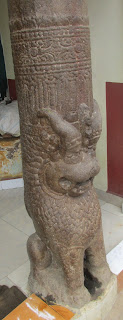Manimangalam Vaikuntha Perumal Temple
Unlike its grandiose counterpart, the Vaikuntha Perumal Temple is a modest abode. In fact, its exact location remains a mystery to many within the village. The temple's doors are rarely ajar, except for a brief five-minute window in the morning, reserved for sacred rituals.
Within the confines of this petite Chola-era temple, resides the endearing form of Vaikuntha Perumal. Seated gracefully, this four-armed deity cradles a conch and discus in the upper hands, extending abhaya hasta from the lower right hand. The left hand, fingers gently folded, rests upon his lap—a unique mudra known as Uri hasta, it is said. Flanked by the divine consorts, Sri Devi and Bhoo Devi, this temple is a sanctuary of serenity.
Unlike temples of grand stature, the Vaikuntha Perumal Temple lacks towering vimanas or additional sub-shrines. At its entrance stands an idol of Ganesh, likely excavated from the village itself. The temple also boasts a few inscriptions from the eras of Raja Raja Chola I and Kulotunga Chola I.
Venturing further, one encounters a contemporary Bhajanai temple in the adjacent lane. This temple finds an intriguing embellishment in the form of two Pallava-period lion pillars adorning its entrance. Remarkably, one of these lion figures sports horns—a distinct representation known as Vyalas. This relic from the Pallava era is a testament to Manimangalam's historical significance as the site of a decisive battle waged by the Pallavas.
As we traverse the bylanes of Manimangalam, we unravel layers of history, each revealing a story of valor, devotion, and cultural richness that has stood the test of time.
Happy travelling.







.JPG)
Comments
Post a Comment